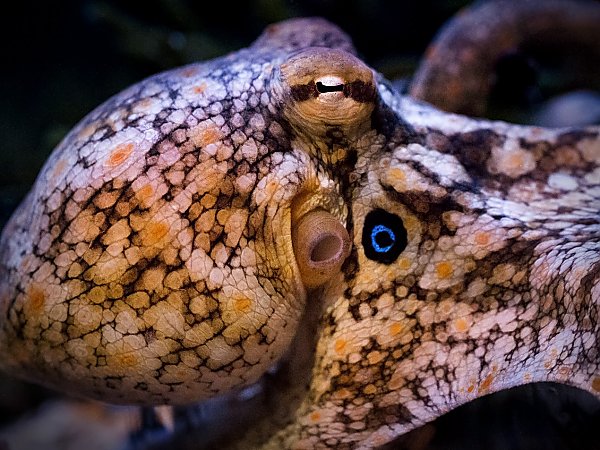California Two-spot Octopus
Octopus bimaculoides
The California two-spot octopus is an intelligent animal named after two blue spots that are located by its eyes. They live along the California coast in shallow waters and are territorial. They use their false eye spots to ward off predators and trick prey. They are semelparous, reproducing once in their lifetime, but produce a large amount of offspring (up to 70,000 eggs!).

Credit: Aquarium of the Pacific/Robin Riggs
SPECIES IN DETAIL
California Two-spot Octopus
Octopus bimaculoides
CONSERVATION STATUS: Safe for Now
CLIMATE CHANGE: Vulnerable
At the Aquarium
Southern California Gallery
Geographic Distribution
The California two-spot octopus can be found in the Pacific Ocean from Northern California to Baja California, Mexico, along the coast.
Habitat
The habitat of California two-spot octopus is rocky reefs, canyon ledges. There they use small caves and crevices to hide.
Physical Characteristics
The California two-spot octopus is brown in color and has two blue spots near their eyes. These spots act as false eyes and help confuse predators. They have the ability to camouflage, changing their color and texture.
Size
Weight:: 4-8 lbs, 2-4 kg Length: 18- 23 inches, (0.5m - 0.6m)
Diet
They feed on small crustaceans, small mollusks, and small fish.
Reproduction
The California two-spot octopus reaches a sexual maturity at around 1 to 2 years. They are semelparous, which means they will only breed once in their lifetime. They can reproduce anytime during the year but mainly in the summer months due to warmer temperatures. A male will fertilize a female and die shortly after. A female California two-spot octopus can lay up to 70,000 eggs. The female tends to the eggs, and does not eat, and dies as a result. At around 150 to 210 days, the babies will hatch from the eggs.
Behavior
The California two-spot octopus is usually active at night hunting for prey. They will leave their burrow and find a new one while hunting at night.
Adaptation
The California two-spot octopus has blue false eye spots under its eyes and this helps it deter predators. It also has chromatophores which are used to help blend into the surrounding areas by changing the color and texture of the body. This helps it both find its prey and avoid predators.
Longevity
The longevity of the California two-spot octopus is around 1 to 1 ½ years in their natural environment but under human care, they have been recorded to live up to 2 years.
Conservation
The California two-spot octopus has a limited range (one coastline) and is susceptible to being caught as bycatch. It is listed as “least concern” on the IUCN Red List.
Special Notes
Despite being susceptible to overfishing, these octopuses are capable of a rapid recovery due how many offspring they can produce.
They have well developed eyes that allow them to see in low light.
They can regenerate arms after losing them to predators such as eels.
SPECIES IN DETAIL | Print full entry
California Two-spot Octopus
Octopus bimaculoides
CONSERVATION STATUS: Safe for Now
CLIMATE CHANGE: Vulnerable
Southern California Gallery
The California two-spot octopus can be found in the Pacific Ocean from Northern California to Baja California, Mexico, along the coast.
The habitat of California two-spot octopus is rocky reefs, canyon ledges. There they use small caves and crevices to hide.
The California two-spot octopus is brown in color and has two blue spots near their eyes. These spots act as false eyes and help confuse predators. They have the ability to camouflage, changing their color and texture.
Weight:: 4-8 lbs, 2-4 kg Length: 18- 23 inches, (0.5m - 0.6m)
They feed on small crustaceans, small mollusks, and small fish.
The California two-spot octopus reaches a sexual maturity at around 1 to 2 years. They are semelparous, which means they will only breed once in their lifetime. They can reproduce anytime during the year but mainly in the summer months due to warmer temperatures. A male will fertilize a female and die shortly after. A female California two-spot octopus can lay up to 70,000 eggs. The female tends to the eggs, and does not eat, and dies as a result. At around 150 to 210 days, the babies will hatch from the eggs.
The California two-spot octopus is usually active at night hunting for prey. They will leave their burrow and find a new one while hunting at night.
The California two-spot octopus has blue false eye spots under its eyes and this helps it deter predators. It also has chromatophores which are used to help blend into the surrounding areas by changing the color and texture of the body. This helps it both find its prey and avoid predators.
The longevity of the California two-spot octopus is around 1 to 1 ½ years in their natural environment but under human care, they have been recorded to live up to 2 years.
The California two-spot octopus has a limited range (one coastline) and is susceptible to being caught as bycatch. It is listed as “least concern” on the IUCN Red List.
Despite being susceptible to overfishing, these octopuses are capable of a rapid recovery due how many offspring they can produce.
They have well developed eyes that allow them to see in low light.
They can regenerate arms after losing them to predators such as eels.

